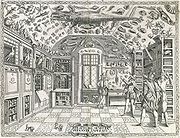
Ferrante Imperato
Encyclopedia

Apothecary
Apothecary is a historical name for a medical professional who formulates and dispenses materia medica to physicians, surgeons and patients — a role now served by a pharmacist and some caregivers....
of Naples
Naples
Naples is a city in Southern Italy, situated on the country's west coast by the Gulf of Naples. Lying between two notable volcanic regions, Mount Vesuvius and the Phlegraean Fields, it is the capital of the region of Campania and of the province of Naples...
, published Dell'Historia Naturale (Naples 1599) and illustrated it with his own cabinet of curiosities
Cabinet of curiosities
A cabinet of curiosities was an encyclopedic collection in Renaissance Europe of types of objects whose categorical boundaries were yet to be defined. They were also known by various names such as Cabinet of Wonder, and in German Kunstkammer or Wunderkammer...
displayed at Palazzo Gravina in Naples; the engraving (illustration, right) became the first pictorial representation of a Renaissance humanist's displayed natural history
Natural history
Natural history is the scientific research of plants or animals, leaning more towards observational rather than experimental methods of study, and encompasses more research published in magazines than in academic journals. Grouped among the natural sciences, natural history is the systematic study...
research collection. The collection, which the published catalogue made as famous in the seventeenth century as that of that other famous apothecary and virtuoso, Francesco Calceolari of Verona, ranged widely; it embraced a herbarium
Herbarium
In botany, a herbarium – sometimes known by the Anglicized term herbar – is a collection of preserved plant specimens. These specimens may be whole plants or plant parts: these will usually be in a dried form, mounted on a sheet, but depending upon the material may also be kept in...
, shells, birds, sea creatures, in addition to the fossils, clays, minerals and metallic ores, marble and gem species. It was maintained by his son Francesco, who assisted him in writing up his observations, and who may be seen in the engraving pointing out details of the specimens to two visitors as Ferrante looks on.
Ferrante Imperato, who ranged southern Italy making geological observations, took as his motto In dies auctior. He was in correspondence with a network of scholars in Italy. He was among the first correctly to identify the processes through which fossil
Fossil
Fossils are the preserved remains or traces of animals , plants, and other organisms from the remote past...
s were formed, subjecting them to empirical tests. His pupil, schooled in the collection, was the jurist Fabio Colonna (1567–1640) who carried further his work on fossils. Ferrante had a small garden and corresponded with botanists, but historians of botany
Botany
Botany, plant science, or plant biology is a branch of biology that involves the scientific study of plant life. Traditionally, botany also included the study of fungi, algae and viruses...
discount his interest in plants as "curiosa".
The book was so sought after that a second edition was issued in Venice, 1672, edited by Giovanni Maria Ferro, who added new material and new illustrations to the concluding chapter.
The catalogue is presented in twenty-eight books, which include nine books devoted to alchemy
Alchemy
Alchemy is an influential philosophical tradition whose early practitioners’ claims to profound powers were known from antiquity. The defining objectives of alchemy are varied; these include the creation of the fabled philosopher's stone possessing powers including the capability of turning base...
, a wholly reputable science at the time, which towards the end of the following century would give birth to chemistry
Chemistry
Chemistry is the science of matter, especially its chemical reactions, but also its composition, structure and properties. Chemistry is concerned with atoms and their interactions with other atoms, and particularly with the properties of chemical bonds....
. Other books are devoted to mining, animals and plant specimens.
Further reading
- Wilson, Wendell E , "Ferrante Imperato (1550–1625). (The History of Mineral Collecting: 1530–1799)" The Mineralogical Record November 1994.

